SPECIAL CALL FOR APPLICATIONS
for sedimentologists and paleontologists (planktic foraminifera) based in ECORD Member Countries to participate in
IODP Expedition 391: Walvis Ridge Hotspot
on-board the JOIDES Resolution
DEADLINE to apply: 4 March 2020
The European Consortium for Ocean Research Drilling (ECORD) offers you the unique opportunity to sail on Expedition 391 on-board the JOIDES Resolution in the framework of the International Ocean Discovery Program (IODP), an international research program for drilling at sea.
Walvis Ridge Hotspot Expedition 391 is a scientific ocean drilling project that seeks to understand the geodynamic significance and origin of the Walvis Ridge (WR), a long-lived hotspot trail that began ~132 Ma at the opening of the South Atlantic Ocean. Because of its duration and volcanic expression, WR is the most influential of Atlantic hotspots and is thought to have a deep mantle plume source that can be projected to the edge of the African large low shear wave velocity province (LLSVP), a hypothesized plume generation zone. The hotspot displays long-lived (since ~70 Ma) isotopic zonation, a characteristic thought to originate at the LLSVP edge, and may be the first example of a hotspot split into three isotopically distinct seamount chains. The hotspot interacted with the Mid-Atlantic Ridge (MAR) for most of its early history, producing both the WR and Rio Grande Rise (RGR). Valdivia Bank, a WR plateau, may have formed with the RGR around a microplate, and this added complexity raises questions about simple plume models and the geodynamic implications of this hotspot trail.
Primary questions are (1) whether the chain splitting and isotopic zonation are consistent with magma sourced at the LLSVP edge and what are the implications for the plume generation zone; (2) whether the chain is strictly age-progressive or whether there were plume pulses, microplates, or continental fragments involved; and (3) what do the expected large shifts in paleolatitude tell us about the fixity and geodynamics of this hotspot.
Expedition 391 is based on IODP Proposals 890-Full2 and 890-Add and will primarily target basaltic lava flows at six primary sites along the older portion of the ridge (~60, ~85, ~110 Ma) to test hypotheses about mantle plume zonation, hotspot drift, and the formation of Walvis Ridge. Basalt samples will be analyzed to document the geochemical and isotopic evolution of Walvis Ridge, especially its division into three isotopically distinct zones after ~60-70 Ma. High-precision geochronology will test models of ridge-hotspot interaction and examine the duration and stages of volcanism at individual sites. Finally, paleomagnetic measurements on igneous samples will constrain paleolatitude changes of seamounts along Walvis Ridge, allowing for more rigorous testing of models of hotspot motion and true polar wander.
Cenozoic intervals of elevated atmospheric CO2 and rapid climate change. Reconstruction of the history of the deep western boundary current and deep-water formation in the Atlantic basins will yield crucial data to test hypotheses regarding the role of evolving thermohaline circulation patterns in climate change, and the effects of tectonic gateways and climate on ocean acidification.
For more information about the expedition science objectives and the JOIDES Resolution expedition schedule, please see http://iodp.tamu.edu/scienceops/ – this site includes links to individual expedition web pages with the original IODP proposal and expedition planning information.
Application deadline: 4 March 2020
WHO SHOULD APPLY: This call is limited to researchers (including graduate students) who are capable to fill the role of a shipboard sedimentologists or palaeontologist (planktic foraminifera).
The Application Process is open to scientists in all ECORD member countries. Please download the Apply to Sail general application forms from the ESSAC webpage:
http://www.ecord.org/expeditions/apply-to-sail/
Please, fill out all applicable fields and send it to the ESSAC office by email (essac@plymouth.ac.uk) with the following additional documents by the deadline of 4 March 2020:
A letter of interest outlining your specific expertise, previous involvement in DSDP/ ODP/ IODP expeditions, research interests, primary research goals of your proposed participation.
CV and publication list.
Young researchers must additionally provide a letter of support from their host institution, including information on post-cruise science support.
All applications should state how you intend to achieve your proposed scientific objectives, with information on the funding scheme and support from your institution or national funding agencies. More information can be found under: http://www.ecord.org/expeditions/apply-to-sail/
In addition to the ESSAC application, all applicants must inform their national office or national delegate and send them a copy of their application documents. The national offices or national delegates can also provide information regarding travel support, post-cruise funding opportunities, etc.
See http://www.ecord.org/about-ecord/about-us/ for a list of the national contact persons.
For further information or questions, please contact the ESSAC Office:
ECORD Science Support & Advisory Committee
Antony Morris (ESSAC Chair)
Hanno Kinkel (ESSAC Science Coordinator)
School of Geography, Earth and Environmental Sciences, Plymouth University, UK
Drake Circus, Plymouth PL4 8AA, UK
e-mail: essac@plymouth.ac.uk
website: www.ecord.org

